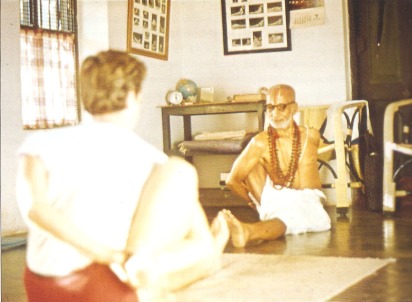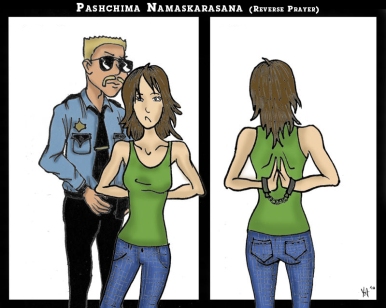My Prayer
So in my previous post, I mentioned about a caucasian lady doing beautiful cross-legged jump throughs. Found out on Day 5 that she is actually apprenticing at The Yoga Shala. Of the three apprentices that day, I can tell she is very new at assisting as she doesn’t seem confident when she adjusts. And she doesn’t assist frequently. Or maybe there is some hours to assist before she can touch students at certain poses? I don’t know. (I just found out there are more than three of them! Some I’ve seen mostly practicing at the shala the intermediate series ^_^ inspiring!)
But she tried to help me in my Parsvottanasana.
I still find difficulty doing the Reverse prayer. Adding to my tight shoulders (main culprit), I also lack wrist mobility to turn my hands to point up without putting a lot of pressure to my pinky fingers. So when she (I ought to know the names of all the teachers next time I see them!) tried to help me, she basically couldn’t do much but release my pinkies which I took the difficulty trying to press together.
I don’t blame her, adjusting people can be a daunting experience. Back at Tirisula, they also tried to help me with my reverse prayer and my hands just won’t budge no matter how much I relax them. That was almost one year ago! o.O
It’s still not a lost case. I’ve slowly managed to grip my fingers on the right side in cow face pose. The other side is still a painful work in progress. ^_^ Practice and all is coming!
Bhujapidasana
Another exciting progress for me was my Bhujapidasana. The previous day I got a really simple adjustment to my prep to Bhujapidasana in order for me to cross my legs with less effort (less effort BY more effort). This is a great way to build up the foundation of this pose.

Alexia Bauer in Bhujapidasana. I just fell in love with the beauty and strength she exudes in this posture.
Land on your toes vs entire feet. Why? I was ending up with almost straight arms which results to my legs sliding down. This was the best way to ensure my arms were bent.
Lift vs walk. I used to cross my legs by walking my feet slowly towards each other as demonstrated by Kino.
Ankles vs Toes. It’s about time I start crossing with my ankles if I want to go down into the full pose.Given the length (or the lack thereof) of my forearms, I don’t have enough clearance to bring my feet through. I used to cross with my toes to compensate the lack of strength to press on my shoulders (literal meaning of Bhujapidasana is Shoulder Press). The next important thing is to have the hamstring strength to lift the feet of the floor in the final pose.
Over time one can jump straight to the pose as shown by Maria Villella in this video:
I’m definitely going to work on this real soon! I’m still having sore wrist from all the jump backs and jump throughs -_-
Supta Kurmasana
This is the real winner for this day.
Since the beginning I have always struggled with poses that press against my shoulders and chest. This is one reason I never progressed in my Bhujapidasana as well. I hate the intense compression on my chest and shoulders. I probably have a really deep-rooted fear that I am yet to discover. ^_^
My Kurmasana isn’t so bad. Still need a bit of chest opening so I can go fully flat to my shoulders. My issue really is cannot move and press my legs as close to my ribs as I can without using my hands. I simply did not know how to do the action.
So to help me get a bind, James simply needed to use brute force.
Right arm first, he pulls it out and back as tight as he could. This was manageable. The second he brings the other arm out for the bind, I mustered all my courage to come back to my breath and relax in the pain. This should be the GOOD KIND OF PAIN, right? The kind of pain that makes me surrender to the moment without giving up. Remembering the lessons I learned during the Vipassana retreat: this too shall pass, and I will come out stronger. 5 breaths later he helped me up on my butt and swung my legs to jump back. That was the tightest I have ever been between my legs!
I know it will take me a while to bind on my own. Months. Probably years. But being able to hold the grip for the full 5 breaths has been the farthest I have come for this pose. Pain all worth it! Pain temporary!
Next step, feet behind the head. o.O
My Thoughts on No Props and modifications/variations
At The Yoga Shala, they follow the strict rule of not using props. No blocks, no straps. No towel allowed for my Prasarita Padottanasana C.
The only time a towel is used is to prevent the hands from slipping in Marichyasana C and D postures. Or maybe for some who cannot grip their big toes with the amount of perspiration.
Variations (beginner variations) are also not allowed. Such as prayer in Parivrtta Parsvakonasana, leg hug or stop sign in Marichyasana C and D. After all, you are practicing in Mysore style.
If they did allow props or variations, I would never be able to do Marichyasana C and D on my own in just a week. I would never be able to know what it’s like to actually grab and hold with your own hands in Supta Kurmasana.
One week at The Yoga Shala has allowed me to do all these things in less time than I would have if I had stuck to my variations and props.
That said, the important thing is knowing the right time to use props and the right time to leave them. And the right class.
I definitely don’t discourage props and variations for the right reasons.
But I strongly discourage the use of yoga socks and gloves. I also would discourage the use of the extra sticky mats (the really sticky ones). These don’t just hinder progression, but can possibly cause injury.
The first time I used the new Lululemon mat (The Mat) I was excited about how sticky it was that I actually recommended it to my students at that time. I have been looking for a mat that will prevent my hands from slipping even in Downward Dog. And my hands were not going anywhere on this mat!
Read this article for a brief history of the yoga mat and its effect on the modern practitioner. Another interesting article sharing the same sentiments.

No sticky mats. Just rugs or carpets.
However, I have experienced knee pain holding my Trikonasana (Triangle Pose) on the Lululemon mat (note that not everyone has the same experience with the same mat).
Super sticky mats make you use less isometric contraction (joint angle and muscle length do not change during contraction). As a result, practitioners tend to put their weight, pressure on the joints. Reliance on the mat to prevent your feet and hands from slipping will result in relaxed, weak adductor muscles.
Try out Trikonasana without your mat and feel the muscles you need you engage to prevent yourself from slipping.
However, I have seen a student with The Mat who could not hold his Pincha as his arms were slipping with the amount of sweat he has in his hands, and mat. It’s always a different story for everyone so try out different mats and see which one suits you best. 🙂
What about the skin?
In some ways the skin can be leveraged as a prop as well. Such as, when you are not [yet] drenched in sweat, the skin can help provide the traction to hold a pose.
Over time, you must develop the strength and technique, engaging the right muscles to hold the pose.
For example:
- Vrksasana (Tree Pose) – hip abduction
- Mayurasana (Peacock) – shoulder adduction
- Arm balances such as Bakasana (Crane, the straight arm), etc – core
- And so on
I will not discuss further on this topic in this post. But hopefully your own practice will teach you this important lesson as well.

